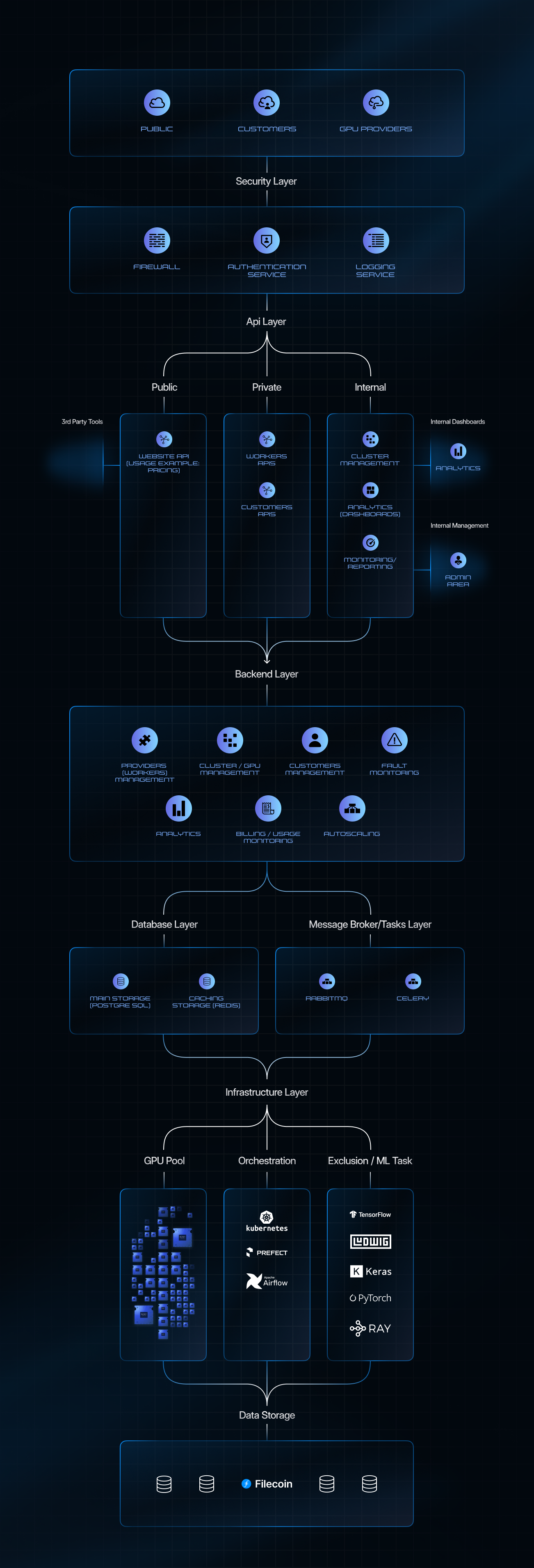IO Architecture
IO.NET's Ecosystem Architecture emphasizes speed, effectiveness, and efficiency. Every element is fine-tuned for swift performance, and we prioritize sustainable, eco-friendly resource use.

The io.net Portal's architecture is a multi-layered, cohesive structure that provides a seamless, secure, and efficient user experience. Each layer has a distinct role, working in tandem to ensure the system's optimal performance. The architecture is built upon modern technologies, ensuring scalability, reliability, and robustness.
User Interface
This layer is the visual gateway for users. It comprises the Public website, Customers area, and GPU providers area (Workers). The design is intuitive and user-centric, ensuring easy navigation and interaction.
Mainly used Tech Stack: ReactJS, Tailwind, web3.js, zustand.
Security Layer
A pivotal layer ensuring the system's integrity and safety. It encompasses a Firewall for network protection, an Authentication Service for user validation, and a Logging Service for tracking activities.
Mainly used Tech Stack:Firewall (pfSense, iptables), Authentication (OAuth, JWT), Logging Service (ELK Stack, Graylog).
API Layer
Serving as the communication bridge, this layer has multiple facets: Public API for the website, Private APIs for Workers/GPU Providers and Customers, and Internal APIs for Cluster Management, Analytics, and Monitoring/Reporting.
Mainly used Tech Stack: FastAPI, Python, GraphQL, RESTful services, gunicorn, solana.
Backend Layer
The system's powerhouse. It manages Providers (Workers), Cluster/GPU operations, Customer interactions, Fault Monitoring, Analytics, Billing/Usage Monitoring, and Autoscaling.
Mainly used Tech Stack: FastAPI, Python, Node.js, Flask, solana, IO-SDK (a fork of Ray 2.3.0), Pandas.
Database Layer
The data repository of the system. It uses Main storage for structured data and Caching for temporary, frequently accessed data.
Mainly used Tech Stack: Postgres (Main storage), Redis (Caching).
Message Broker/Task Layer
This layer orchestrates asynchronous communications and task management, ensuring smooth data flow and efficient task execution.
Mainly used Tech Stack: RabbitMQ (Message Broker), Celery (Task Management).
Infrastructure Layer
The foundational layer. It houses the GPU Pool with hardware from our verified partners. Orchestration tools manage deployments, while Execution/ML Tasks handle computations and machine learning operations. Additionally, it provides Data Storage solutions. GPU performance is monitored using Nvidia-smi or NVIDIA DCGM.
Mainly used Tech Stack:
- GPU/CPU Pool
- Orchestration: Kubernetes, Prefect, Apache Airflow
- Execution/ML Tasks: Ray, Ludwig, Pytorch, Keras, TensorFlow, Pandas
- Data Storage: Amazon S3, Hadoop HDFS
- Сontainerization: Docker
- Monitoring: Grafana, Datadog, Prometheus, NVIDIA DCGM
IO-SDK: The Powerhouse Behind IO.NET
IO-SDK is our specialized fork of Ray, a core technology driving IO.NET's capabilities. Embracing Ray's native parallelism, IO-SDK effortlessly parallelizes Python functions, enabling dynamic task execution. Its in-memory storage ensures rapid data sharing between tasks, eliminating serialization delays. The dynamic auto-scaling feature means IO-SDK can quickly adapt to computational demands. Moreover, it's not just limited to Python; its language versatility and integration capabilities with leading ML frameworks like PyTorch and TensorFlow make it a robust and flexible choice. Whether on a single machine or a vast cloud platform, IO-SDK ensures IO.NET's scalability and performance.
Together, these layers, powered by the mentioned tech stacks, form a robust and scalable architecture for the IO.NET Portal, ensuring it meets the demands of modern users and remains future-proof.
Updated 22 days ago